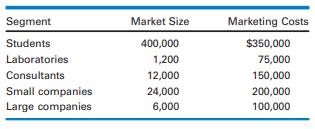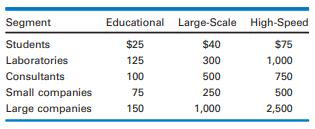Refer to the Snoey Software Company case. From the corresponding exercise in Chapter 3, review the design
Question:
Refer to the Snoey Software Company case. From the corresponding exercise in Chapter 3, review the design of a spreadsheet for the desired five-year economic analysis mentioned in the case.
a. Consider a recommendation that the prices for the Educational, Large-Scale, and High-Speed versions should be $75, $275, and $475, respectively. What annual profit would these prices achieve?
b. Construct three separate sensitivity analyses, starting from the base case in (a). For each analysis, vary the price above and below the base case, and find the best price for the version being analyzed. When these prices are used in combination, what annual profit is achieved?
c. For the pricing in (a), consider the set of prices that the five segments would be willing to pay for the three products. If each of these prices could vary by 15 percent, which one would have the greatest dollar impact on the annual profit?
SNOEY SOFTWARE COMPANY
Snoey Software Company is developing a new piece of software that can be tailored to various market segments. At this stage, the developers envision three versions of the software: an Educational version, a Large-Scale version, and a High-Speed version. Each is built around the same basic design, but a number of data-handling and input/output procedures are different in the different versions. By creating these versions, Snoey hopes to extract more value from the marketplace than it could obtain with just one version.
Currently, the developers are close to completing the Educational version, but they have done little more than outline the other two versions. The estimated R&D expenditures required to finish those tasks are $100,000 for the Large-Scale version, and $150,000 for the High-Speed version. The actual variable costs are estimated to be $10 for the Educational version, $20 for the Large-Scale version, and $36 for the High-Speed version.
The marketing director at Snoey Software has identified five market segments that would respond differently to the new software: (1) university students, (2) academic and government laboratories, (3) consultants, (4) small companies, and (5) large companies. The potential sales in each of these markets, together with the cost of advertising in each market, are as follows:

In a series of surveys and focus groups, the marketing staff has tested the interest of each market segment in the three different versions of the software. The results of the tests have been summarized in a table of values that represent the prices each segment would be willing to pay for each of the versions. This information is shown in the following table.

In order to develop a price structure for the software, the marketing director uses the following logic. For each segment and for each version, the potential customer will calculate the difference between the price and the value. The highest difference will dictate what the customer will purchase. On that basis, it will be possible to estimate the sales volumes of each version in each segment and compute the resulting profits.
You have been hired to build a model that will compute the sales of each version in each market segment and then calculate the resulting profit for Snoey Software. Given the approach they have taken thus far, the company is committed to the Educational version, but it could halt development activities on either or both of the other versions. The question on everybody’s mind is: which versions should be brought to market?
Step by Step Answer:

Management Science The Art Of Modeling With Spreadsheets
ISBN: 1301
4th Edition
Authors: Stephen G. Powell, Kenneth R. Baker





